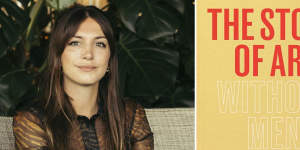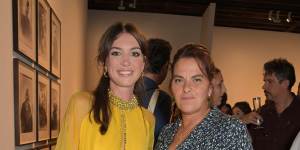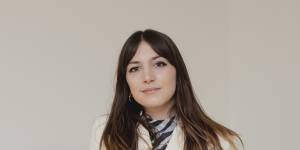“It hurt like a wound to the heart,” Hessel says over a Zoom call from London. “I cried so much and skipped all my lessons that day. At the same time,I wouldn’t have suited a Cambridge education,so in a way everything always works out,and also it fuelled me to say,‘OK,I clearly am not good enough,so I have to try harder’.”
“Try harder” seems an understatement. Twelve years on and Hessel is an art-world sensation – Instagram star,podcaster,columnist forThe Guardian,television presenter for the BBC,and bestselling author who has carved a niche for herself by promoting the work of women artists.
,published in 2022 by Hutchinson Heinemann,is a sweeping roll-call of female artists from 1500 to the present,and a lively riposte to E. H. Gombrich’s seminal textThe Story of Art,which included zero women artists when first published in 1950,and even in its 16th edition admitted only one – German artist Kathe Kollwitz (1867-1945).
“I read Gombrich as a teen and I loved it,” Hessel says. “It was a great book to have to rewrite.”
If Gombrich were alive (he died in 2001),he might be at least partially pleased to hear it;in his classic text,the Austrian-born art historian acknowledged that he was thinking “first and foremost of readers in their teens who had just discovered the world of art for themselves”. Like Gombrich,Hessel seeks to demystify the arts and appeal to a broad audience – “anyone of any art-historical level interested in learning the stories of these mostly overshadowed artists”,as she writes in her introduction.
Gombrich’s exclusion of women did him no harm;his book has sold more than 7 million copies. But times have changed,and there’s a hunger for revisionist histories such as Hessel’s that take hearty swipes at the big boys of international art.
Hessel dismisses,for instance,the entire Neo-Expressionist movement,with its “colossal and oh-so-tormented paintings”,as “misogynistic and egotistical”. How one feels about such pronouncements will depend on one’s outlook and taste – and Hessel’s book is not to everyone’s taste. What is also emphatically true is thatThe Story of Art Without Men has fans in droves:it made it on to the bestseller lists ofThe New York Times andThe Sunday Times,and was named book of the year in 2022 by respected British bookstore chain Waterstones;previous winners include Sally Rooney’sNormal People (2018).
In the wake of Hessel’s success,Cambridge University made amends,last year anointing her a Visiting Fellow,a development Hessel duly posted on Instagram alongside a photo of herself in a scholar’s gown over a stylish,dark-green velvet jacket and matching palazzo pants.
Next month Hessel lands on our shores with a busy schedule – seven talks over 11 days in Sydney,Melbourne and Brisbane.
“I’ve never been before … it’s so exciting,I can’t tell you,” the 30-year-old says in her mellifluous British accent. She’s speaking to me from the London Library,her preferred writing space. Smartly dressed in a beige trench coat,close-necked white shirt and ribbon bow-tie,Hessel looks the epitome of London cool.

Katy Hessel’s The Story of Art Without Men is a corrective to other art histories.Supplied
Her first Australian appearance,at the Sydney Writers’ Festival,will be in conversation with acclaimed photographer and filmmaker Tracey Moffatt,who represented Australia at the Venice Biennale in 2017. Moffatt is not featured in Hessel’s book. Only one Australian artist made the cut – the remarkable Anmatyerr woman Emily Kam Kngwarray,who took the contemporary art world by storm in the early 1990s with her vigorous paintings depicting Country and ceremony.
“There should be more!” Hessel says with apologetic eagerness. “Tracey Moffatt should absolutely be in the book. But I didn’t know her work well enough then,and I will after I get back from Australia.”
The most challenging aspect of writing the book,Hessel says,was deciding who to leave out. “That book is totally not the definitive history book.”
Written in less than three years,chiefly during the pandemic lockdowns when distractions were minimal,Hessel’s fast-paced,520-page book follows Gombrich in using the Western canon as a framework to list women’s achievements across time and art movements,from the Renaissance to pop art to performance art and so on,culminating with the work of three contemporary British painters born in the 1990s:Jadé Fadojutimi,Flora Yukhnovich and Somaya Critchlow.
Along the way we meet impressive women such as the self-taught Dominican nun Plautilla Nelli (1524-1588),who set up an all-female workshop at her convent in Florence;German-Jewish artist Charlotte Salomon (1917-1943),who recorded her experiences during the rise of Nazism,producing art in the most challenging circumstances;and sculptor Augusta Savage (1892-1962),the first African-American woman to open a private art gallery in the United States.

Hessel with artist Tracey Emin at the launch of her book in London in September 2022.Dave Benett/Getty Images
Hessel’s own rise in the arts is as much a measure of her determination to advance the cause of women artists as it is of her clever harnessing of Instagram.
In October 2015,after visiting an art fair where she claims to have seen not a single work by a female artist,Hessel was so shocked that she decided to launch an Instagram account celebrating women. She named the accountThe Great Women Artists,after American art historian Linda Nochlin’s groundbreaking and provocative essay “Why have there been no great women artists?”,first published in 1971.
Hessel began the account without knowing whether anyone would follow it. “And no one really did follow it for the first couple of years,and I just did it every single day and it was great. I never knew that it would turn into this,” Hessel says.
“This” being the book that grew out of her Instagram account,which has now clocked up 394,000 followers and spawned a podcast of the same name,begun in 2019,where Hessel has interviewed artists including Marina Abramovic and Tracey Emin.
When Instagram was still an emerging social media platform,there was greater potential to forge a career on the site and make friends with people of influence,and Hessel duly did. “It was amazing because suddenly every museum director or gallery or artist started getting an account,” she recalls. “[Then-director of the Tate Modern] Frances Morris and I were following each other,[British painter] Cecily Brown and I were DM-ing … it was like,‘oh my god,Cecily Brown is following me and I’m just this front-desk person at a gallery’.
“No one knew how old I was,they didn’t know what I looked like,and then I curated an exhibition in 2017,when I was 23,and a thousand people came to opening night,and I was like,‘oh my god,people know about this thing’,and it was really cool.
“It wouldn’t really work now because[Instagram] is not so much of a phenomenon,but back then it was something new. I’ve used it for my work to be an art historian because I didn’t have a masters or a PhD,which is kind of blasphemous in certain cases,” Hessel says,pulling a mock-horror face.

“I never knew that it would turn into this”:Hessel’s Instagram success has led to a bestselling book and a podcast.Luke Fullalove
Hessel did end up completing a degree in art history,at University College London,ranked nine in the world to Cambridge’s number two,nothing to be ashamed about. “UCL was amazing,” Hessel says,naming some of her distinguished teachers such as art historians Briony Fer and Tamar Garb,who she lists in her book’s acknowledgments along with many other art-world luminaries. “It was such a collaborative process,” Hessel says of the book.
Hessel grew up in north-west London,the youngest of four siblings,with parents who would often send their kids off to explore the city’s renowned museums. She was only six years old when the Turbine Hall opened at the Tate Modern in May 2000,and entering that vast space was her first momentous encounter with art.
“I just remember being completely awestruck by the sheer scale of it and this idea that this could be an art space and the kind of experiments that artists could make in this room that were just out of this world.”
Twenty-four years on,Hessel seems to have lost none of her sense of wonder for the arts. During our hour-long call,her energy never wavers;words rush out of her with such genuine enthusiasm that it’s wildly refreshing and mildly exhausting.
While Hessel’s book has received glowing reviews –The Guardian’s Bidisha Mamata described it as “inspiring and indispensable” – some critics have been less fond of its effusive style. “Some of the writing is more akin to the caffeine rush of the like than to considered prose,” wrote Stuart Kelly inThe Scotsman. Hessel has also been criticised for her dependence on existing scholarship and for adopting a Western canon approach,the very structure that notoriously excluded women. So,as a retelling of art history from a feminist perspective,just how radical is Hessel’s book?
‘It’s about fighting the cause and making art as widely accessible as possible … I’m not an academic.’
“If you’re an art historian,you may not learn that much from it necessarily,” says Elspeth Pitt,senior curator of Australian art at the National Gallery of Australia and co-editor of theKnow My Name catalogue that was published in 2020 as part of the gallery’s mission to address the notable lack of women in its collection.
“But what Katy has done is brought together a story of art,like the title says. It’s a strong narrative and it’s one that’s been able to speak to a really broad audience,and I think that’s the significant and pioneering aspect of the book,” Pitt says.
“She’s had to rely,of course,extremely heavily on other people’s scholarship,but what she has done really well is to bring hugely diverse sources together … To my knowledge,no one had attempted that kind of really broad-ranging history over a 500-year period. So you know,it’s something pretty gutsy that she has endeavoured to do. And she has been able to reach an audience that I think,as academics and as curators,you don’t often see.”
Feminist art historian and former curator of Australian art at the NGA,Lara Nicholls,also applauds how Hessel has helped raise awareness about gender inequality in the visual arts to a new generation,particularly through her podcast.
“That is a great achievement,” says Nicholls,now curator of art at the Australian War Memorial. She adds,however:“I don’t see what is new in this literature,as all of these points were made by feminist art historians in the 1970s. Yet this book is packaged as ‘pioneering’. In fact,many of the issues Hessel raises,Virginia Woolf raised in 1928 inA Room of One’s Own,summed up in her famous quote,‘I would venture to guess that Anon,who wrote so many poems without signing them,was often a woman’. There was also considerable literature in the 19th century about women artists and their representation. This is not a new subject. Although I guess misogyny is a perennial problem which,rather tediously,we must continue to call out.”
Hessel accepts the criticism with goodwill and welcomes debate. “For me,at the end of the day,it’s about fighting the cause and making art as widely accessible to everyone as possible,and I’m not an academic. I don’t claim to be an academic,and I try and platform academics as much as possible on my podcast or anything.”
She’s also penned an essay in response to some of the criticism levelled against her,in which she poses the question,“who gets to write the history of art?”,to be included in the paperback edition of her book being released later this year.
“Having written the book and reflecting on it over the last two years,was that the right way to do it? I don’t know,” Hessel says. “I don’t know what the right way to do it is. It’saway.”
Katy Hessel is speaking at the Sydney Writers’ Festival on May 22,in conversation with Tracey Moffatt,and on May 25;and at the National Gallery of Victoria on May 29.
To read more from Spectrum,.